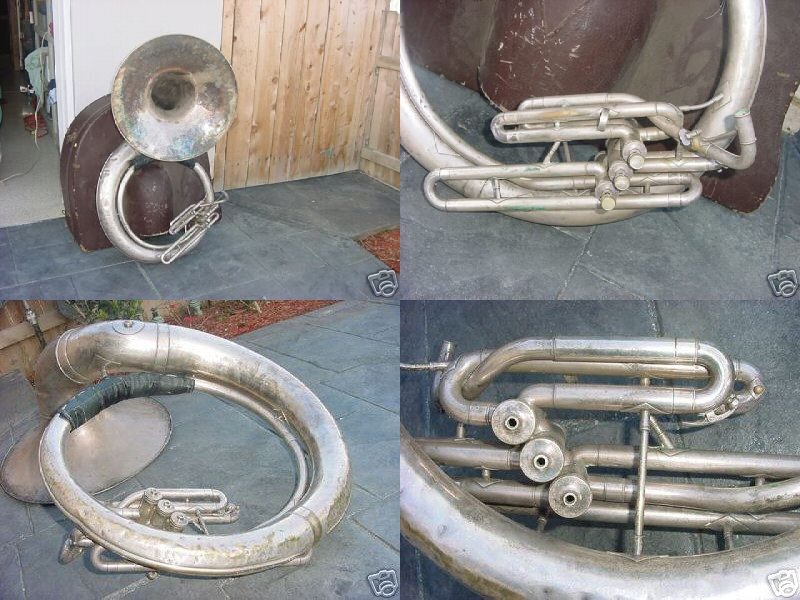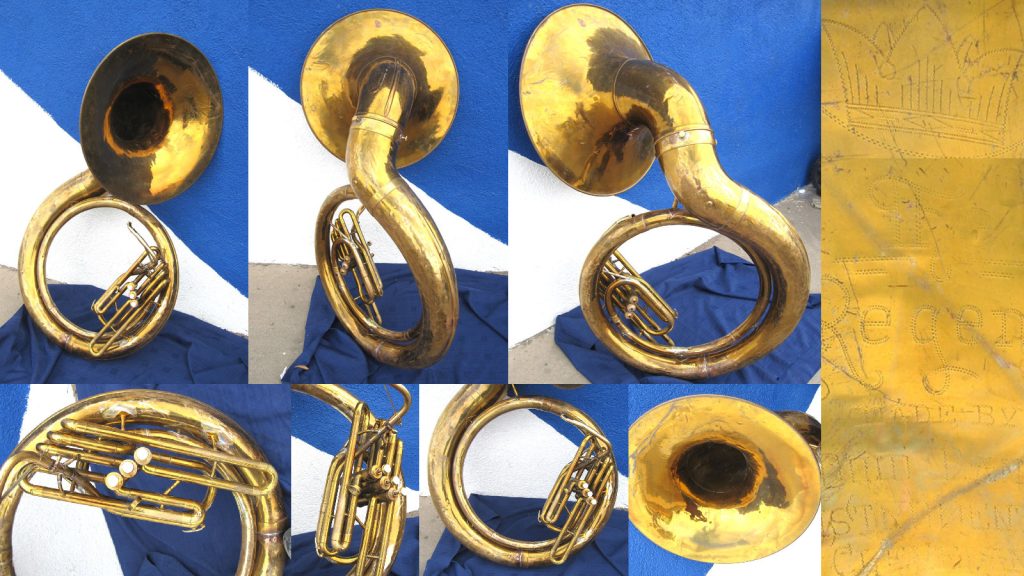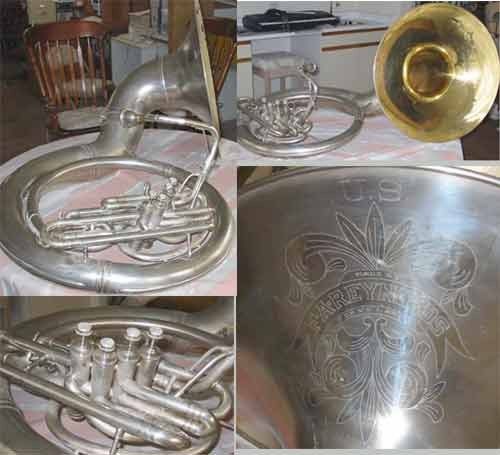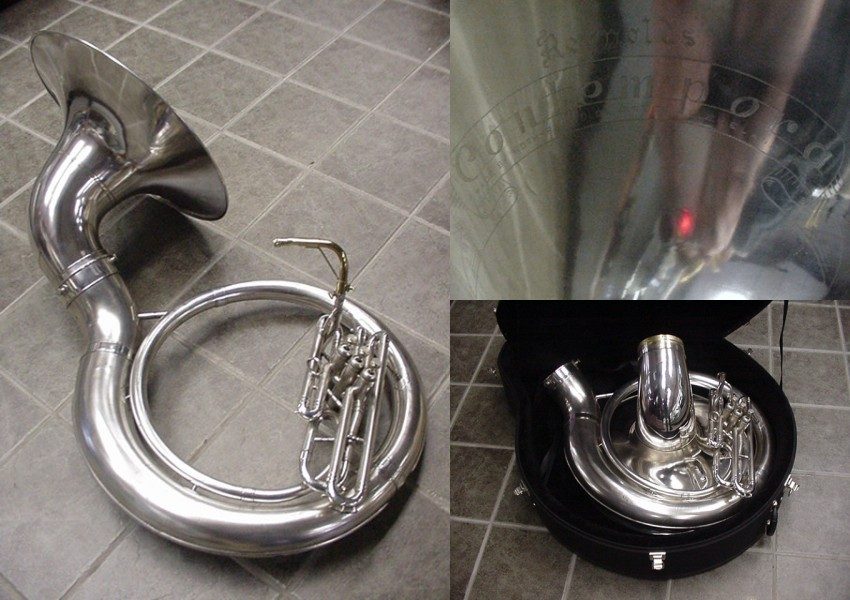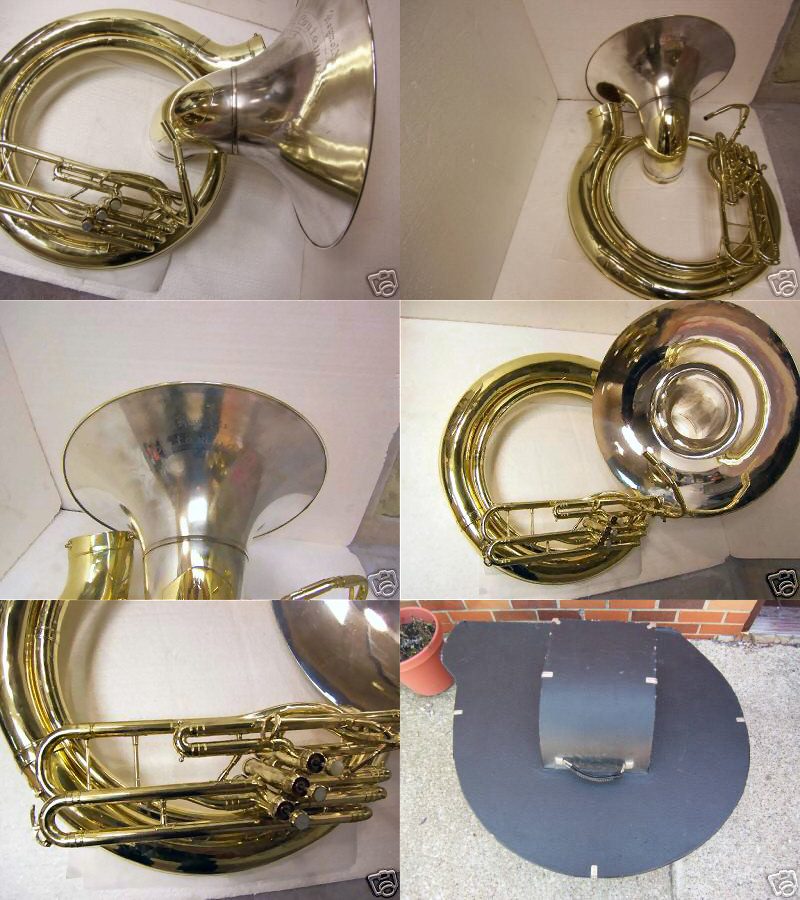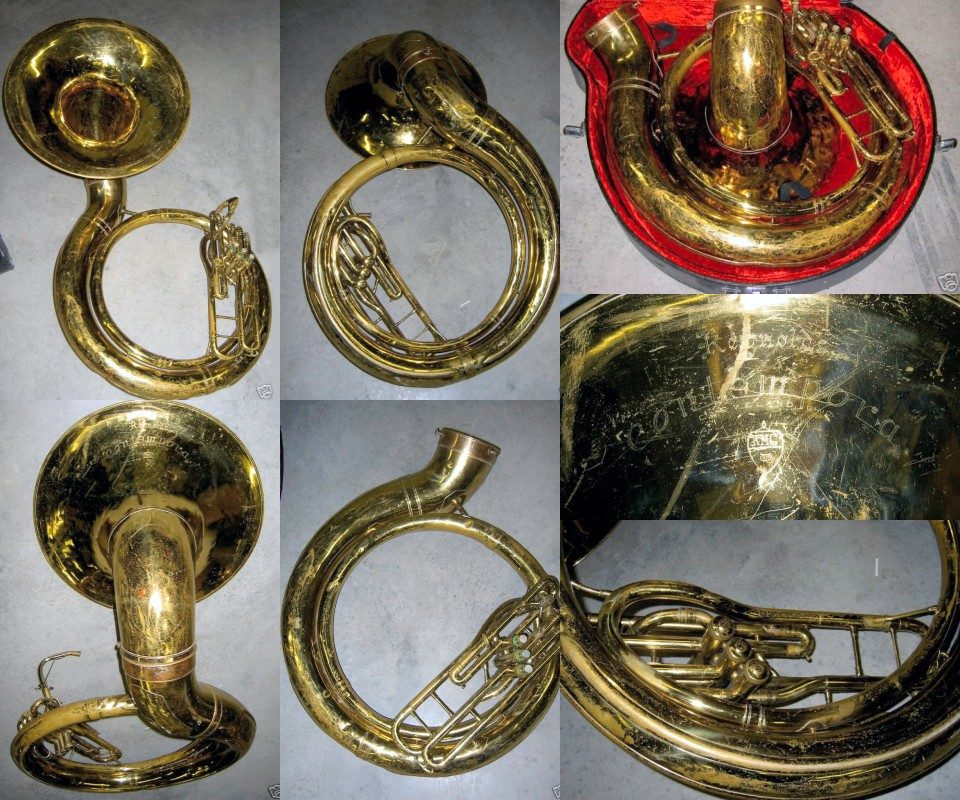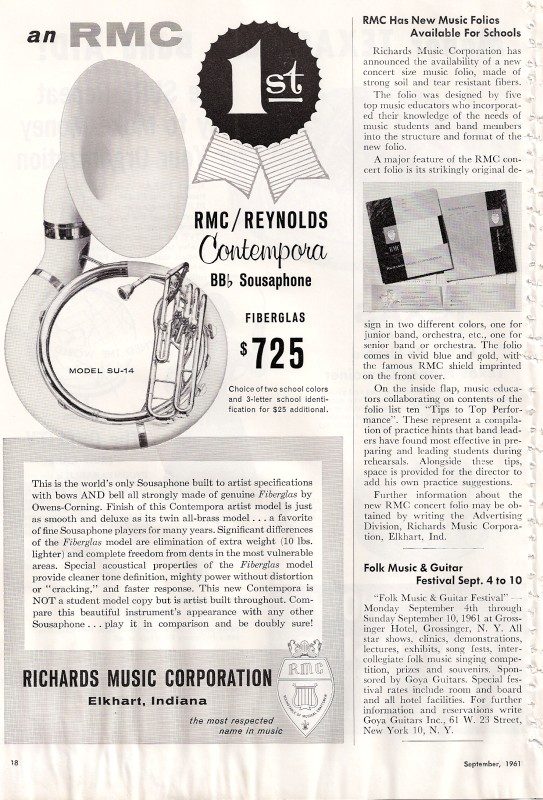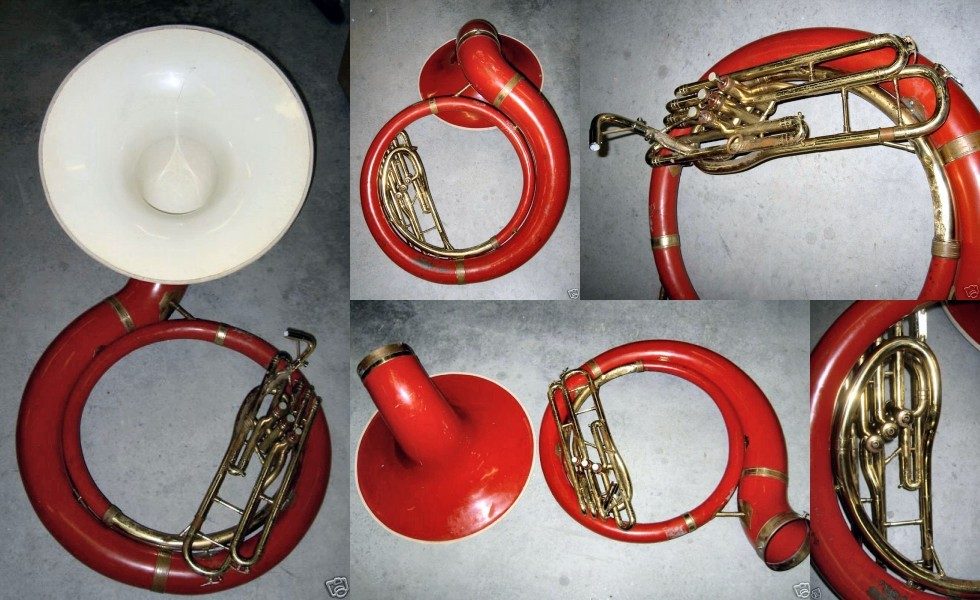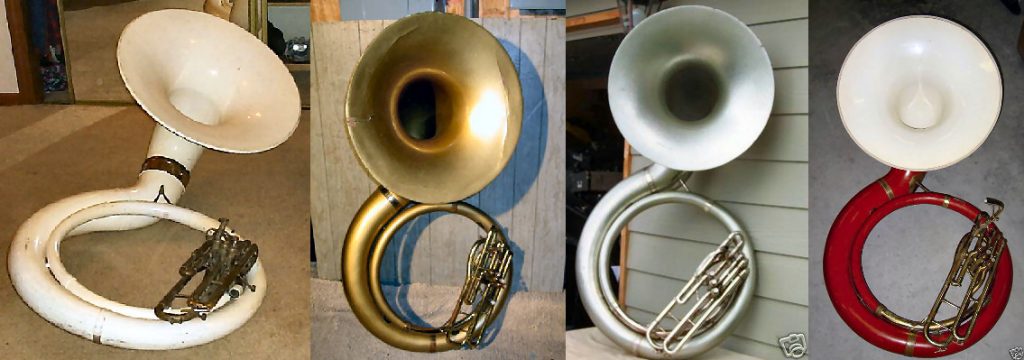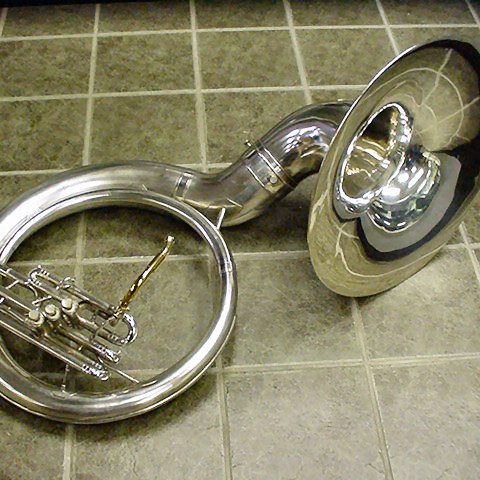
F.A. Reynolds made sousaphones from the beginning, including models in E♭ and BB♭, for both the Reynolds and Regent lines. Photos of U.S. Army Air Force bands show sousaphones as the bass voice instrument, so it is likely that Reynolds focused on producing those exclusively through World War 2, before adding recording basses to the catalog in the late 1940s.
1936-1949
F.A. Reynolds (Cleveland, Ohio)
Some variations have been seen within Reynolds sousaphones, e.g. some with nickel-silver valve slide crooks vs others with brass, but not enough to possibly assign as unique model lines (like with the trumpets and cornets).
A Sousaphone player, by the very nature of his important foundational part in the band, has every reason to want the best ... In the Reynolds he gets it.
Here is the most graceful instrument ever designed, with the ruggedness and full-throated tone that blends with and yet asserts itself in the band.
Especially prominent in marching bands, it still is a fine, big, robust "gentleman" in a concert band. Beautiful in contour, it hugs the player comfortably and makes his work a pleasure. Its response ranges from the faintest whisper to the mightiest volume, with never a "crack." Try its soft easy mouthpiece on your own embouchure and hear for yourself. You'll be convinced.
Regent instruments were made by Ohio Band Instrument Co., a subsidiary of F.A. Reynolds, using the same factory machines and craftsmen as the parent company.
As the most commanding instruments in the band, Sousaphones must be of outstanding appearance. The biggest member of THE REGENT family has a 24" detachable bell, both in the E♭ and BB♭ models. These Sousaphones are essentially precision instruments and have ample volume. Built in regulation size, they produce a deep, vibrant organ tone, necessary and desirable in this type instrument.
World War II
Throughout the 1940s, F.A. Reynolds Co. was awarded contracts by the U.S. Army Quartermaster for band instruments, becoming "a major source of supply for the Armed Forces during World War II." [1977 catalog] These instruments have a silverplate finish with unique engraving and a large "U.S." mark near the rim of the bell. Known serial numbers date production from between 1940 and 1952.
These contracts allowed the relatively new company to continue focusing on making band instruments when more-established manufacturers, e.g., F.E. Olds and Conn, were forced to shut down instrument lines and produce wartime equipment. Details of the contracts are not available, and it is not specified which service bands received the instruments, though anecdotal evidence suggests that the bands of the U.S. Army Air Forces (USAAF) may have been recipients, having just organized in 1941.
1949-1952
F.A. Reynolds, division of Scherl & Roth (Cleveland, Ohio)
The Contempora line launched in 1949 with new trumpet and bass trombone models, followed by cornet and tenor trombone. A year later, most original "F.A. Reynolds" instruments had been rebranded on paper as "Contempora" instruments, including the Sousaphones, though they were still referred to as "Reynolds" instruments throughout the 1950s. It is undetermined if the "Contempora" name was engraved prior to 1952, so many of these instruments may look the same as the F.A. Reynolds models.
Model 130
Reynolds Contempora E♭ Sousaphone
Bore: .687"
Bell: 23"
Weight: 23 lbs (including mouthpiece and lyre)
Valves: three side-action piston valves
Materials: brass with nickel-silver valve caps, bracing and trim
Finish: polished brass with clear lacquer finish; optional silverplate with bright bell (131) or gold bell (132) finish
Model 140
Reynolds Contempora BB♭ Sousaphone
Bore: .687"
Bell: 25"
Weight: 28½ lbs (including mouthpiece and lyre)
Valves: three side-action piston valves
Materials: brass with nickel-silver valve caps, bracing and trim
Finish: polished brass with clear lacquer finish; optional silverplate with bright bell (141) or gold bell (142) finish
Reynolds Sousaphones are built in both BB♭ and E♭ models. They are outstanding in appearance and design and perfectly balanced. The tone is rich and colorful. While tremendous volume is available, the voicing is flexible and sensitive to attack, ranging from the softest tones to its unlimited power without any "cracking."
1952-1961
Roth-Reynolds (Cleveland, Ohio)
Sousaphones made from 1952-1960 should have "Contempora" and "Made by Roth-Reynolds" engraved on the bell.
Reynolds Contempora Sousaphones are a guarantee of a fine musical foundation in any organization. Graceful in appearance and designed for easy, comfortable handling, Contempora Sousaphones have the penetrating, round bass sound preferred by discriminating directors. Full tone throughout the entire range. Mighty power without distortion or 'cracking.' A masterpiece by Roth-Reynolds, built for years and years of dependable service. Available in BB♭ or E♭ models, in three different finishes. Form-fitting case extra.
Model 130
Reynolds Contempora E♭ Sousaphone
Bore: .687"
Bell: 23"
Weight: 23 lbs (including mouthpiece and lyre)
Valves: three side-action piston valves
Materials: brass with nickel-silver valve caps, bracing and trim
Finish: polished brass with clear lacquer finish; optional silverplate with bright bell (131) or gold bell (132) finish
Model 140
Reynolds Contempora BB♭ Sousaphone
Bore: .687"
Bell: 25"
Weight: 28½ lbs (including mouthpiece and lyre)
Valves: three side-action piston valves
Materials: brass with nickel-silver valve caps, bracing and trim
Finish: polished brass with clear lacquer finish; optional silverplate with bright bell (141) or gold bell (142) finish
1961-1964
RMC/Reynolds (Cleveland, Ohio)
Sometime after Richards Music purchased Reynolds in 1961, the product catalog was reorganized. Old model numbers were replaced with a new scheme that incorporated an abbreviation for the type of instrument, e.g. "FE" for French Horn, and a hierarchal numbering system that reflected the grade of instrument, e.g. "01" for top-level artist instruments, "56" for student horns. To the best of knowledge, the instrument specifications did not change, just the model numbers. The new numbering system was used for the rest of the company's history.
Model SU-11
Reynolds Contempora BB♭ Sousaphone
Bore: .687"
Bell: 25"
Weight: 28 lbs (including mouthpiece and lyre)
Valves: three side-action piston valves
Materials: brass with nickel-silver valve caps, bracing and trim
Finish: polished brass with clear lacquer finish; optional silverplate with bright bell or gold bell finish
For those who prefer the traditional all-brass instrument, this model by Reynolds has the finest possible features built into it. It is sturdily braced. The bell ring is doubly reinforced. ... Available in brass finish or optional silverplate with bright bell or silverplate and gold bell. One piece formed cases available at extra cost.
Model SU-12
Reynolds Contempora E♭ Sousaphone
Bore: .687"
Bell: 23"
Weight: 23 lbs (including mouthpiece and lyre)
Valves: three side-action piston valves
Materials: brass with nickel-silver valve caps, bracing and trim
Finish: polished brass with clear lacquer finish; optional silverplate with bright bell or gold bell finish
New to the Reynolds catalog in 1961 was the introduction of a Fiberglass Sousaphone. Promising significant weight reduction and a variety of colors and finishes, the model married the traditional brass valve section to a fiberglass body and bell. Conn had announced their fiberglass sousaphone at the NAMM convention in July 1961—the RMC advertisement below appeared in September of that same year.
"This is the world’s only Sousaphone built to artist specifications with bows AND bell all strongly made of genuine Fiberglas by Owens-Corning. Finish of this Contempora artist model is just as smooth and deluxe as its twin all-brass model … a favorite of fine Sousaphone players for many years. Significant differences of the Fiberglas model are elimination of extra weight (10 lbs. lighter) and complete freedom from dents in the most vulnerable areas. Special acoustical properties of the Fiberglas model provide cleaner tone definition, mighty power without distortion or ‘cracking’, and faster response. This new Contempora is NOT a student model copy but is artist built throughout. Compare this beautiful instrument’s appearance with any other Sousaphone … play it in comparison and be doubly sure!"
Model SU-14
Reynolds Contempora BB♭ Fiberglass Sousaphone
Bore: .687"
Bell: 25"
Weight: 18 lbs
Valves: three side-action piston valves
Materials: fiberglass bell, branches and bows; brass valve section with nickel-silver valve caps, bracing and trim
Finish: brass or silverplate simulated finish; other colors or metallic glitter available
Built to artists' specifications with outside branches, bows and one-piece bell all strongly made of genuine fiberglass. Brass section from mouthpipe to beginning of fiberglass is quickly and easily removed for repairs at any time and is identical to brass sousaphones previously developed. ... Finish closely simulates brass or silverplate. Also available in other colors or metallic glitter as specified. Three-letter school identification also optional at extra cost.
1964-1970
Reynolds (Fullerton, Calif.; Abilene, Texas)
After CMI purchased the assets to Reynolds, background and low brass instruments were produced at the Reynolds factory in Abilene, Texas. There were slight adjustments to the model specifications compared to the Cleveland instruments. It has been reported that some parts—e.g., baritone and low brass bells—were manufactured at the Olds plant in Fullerton and shipped to Abilene to be assembled with parts made there.
From the marching field to the concert stage, the SU-11 is equally at home. Quiet, fast valve action in technial passages — a smooth, singing tone in lyrical passages — both are characteristic of Reynolds because of the skill and artistry built into each instrument. Modern tooling and the latest ideas of design make the SU-11 the choice of many of the country’s top performers and conductors.
Model SU-11
Reynolds Contempora BB♭ Sousaphone
Bore: .686"
Bell: 25"
Weight: 28 lbs (including mouthpiece and lyre)
Valves: three side-action piston valves
Materials: brass with nickel-silver valve caps, bracing and trim
Finish: polished brass with baked epoxy finish; optional silverplate with bright bell or gold bell finish
Model SU-12
Reynolds Contempora E♭ Sousaphone
Bore: .686"
Bell: 23"
Weight: 23 lbs (including mouthpiece and lyre)
Valves: three side-action piston valves
Materials: brass with nickel-silver valve caps, bracing and trim
Finish: polished brass with baked epoxy finish; optional silverplate with bright bell or gold bell finish
The Reynolds SU-12 (E♭) cannot be matched as a lightweight instrument for the younger player or for more advanced players who must play in the upper register. Forty years of manufacturing and design experience combined with the finest tooling available assure effortless response, precise intonation, and rugged durability. Full bodied, yet flexible, this instrument meets the demands of the most discriminating performer.
Body branches, body and bell bows are damage-resistant fiberglass-reinforced plastic; bell flare in high-impact flexible plastic with moulded reinforcement. Structural braces have wide flanges imbedded in fiberglass. Weighs only 18 lbs! Sprayed, hard-baked epoxy finish in gleaming white or simulated satin-finish brass or silver-plate resists mars and scratches. Brass or silver valve section. Valve section easily removed for repair if needed. School colors available on special orders at extra cost.
Model SU-14
Reynolds Contempora BB♭ Fiberglass Sousaphone
Bore: .686"
Bell: 24"
Weight: 18 lbs
Valves: three side-action piston valves
Materials: fiberglass-reinforced plastic body; high-impact flexible plastic bell flare with molded reinforcements; brass valve section, receiver and mouthpipe
Finish: polished brass with baked epoxy finish (valve section); white or simulated satin brass or silverplate epoxy finish (body and bell); other colors available
1970-1979
Reynolds (Fullerton, Calif.)
In 1970, Reynolds merged production lines with Olds in Fullerton and sold the Abilene plant to Conn. It appears that the brass sousaphones either did not make the transition to California, or were discontinued shortly thereafter. The 1970 catalog is their last documented appearance. The fiberglass sousaphone continued to be made, both as Reynolds and Olds models.
Model SU-14
Reynolds Contempora BB♭ Fiberglass Sousaphone
Bore: .686"
Bell: 24"
Weight: 18 lbs
Valves: three side-action piston valves
Materials: fiberglass-reinforced plastic body; high-impact flexible plastic bell flare with molded reinforcements; brass valve section, receiver and mouthpipe
Finish: polished brass with baked epoxy finish (valve section); white or simulated satin brass or silverplate epoxy finish (body and bell); other colors available
Here’s a lightweight sousaphone with excellent weight distribution. Highly responsive, with an evenly balanced tone in all registers. The body is constructed of a damage-resistant fiberglass which prevents scratching. The detachable bell is made of durable ABS with molded reinforcements.
The purpose of this website is to preserve the history of the F. A. Reynolds Company and the distinctive qualities of its brass instruments. Contempora Corner and contemporacorner.com are not related or associated in any way to the former or current F.A. Reynolds Company.
Copyright © 2004-2024 ElShaddai Edwards. All Rights Reserved. Terms of Use.

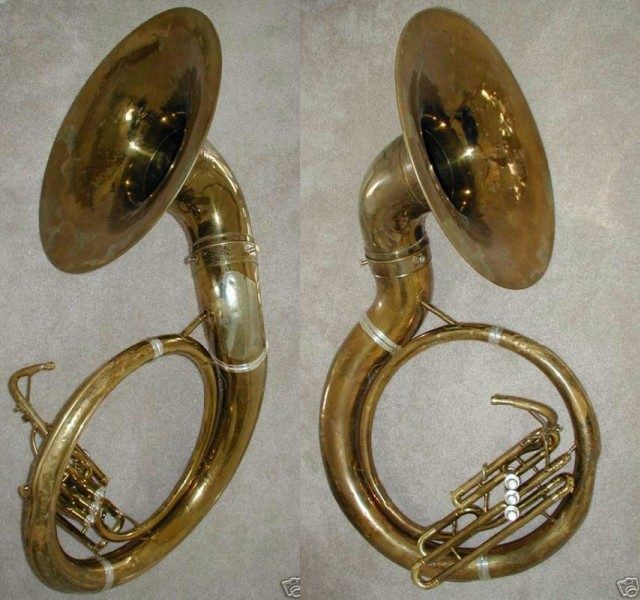
![Model TBD [SN 17933]. Photos used with permission from Lew Chasalow (eBay Member: vintagebrass).](https://contemporacorner.com/wp-content/uploads/2009/07/017933.jpg)
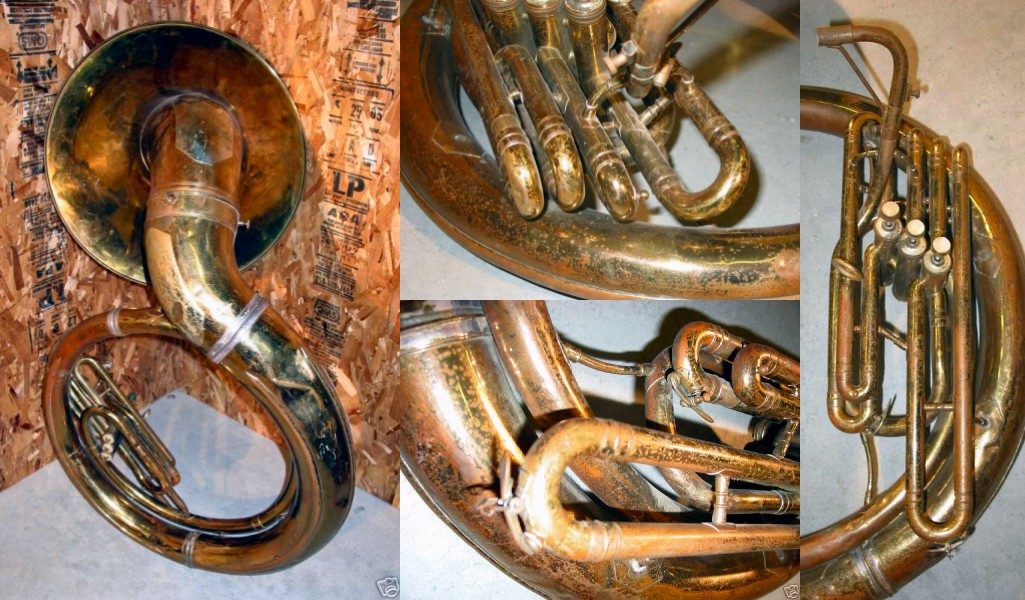
![Model TBD [SN 1842]. Photo source: eBay.](https://contemporacorner.com/wp-content/uploads/2009/07/001842.jpg)
